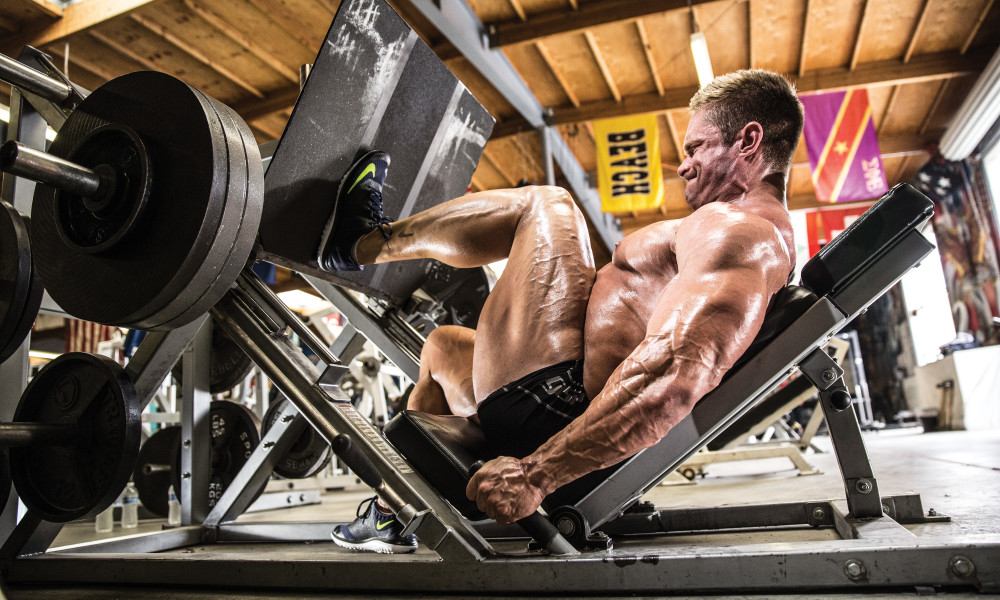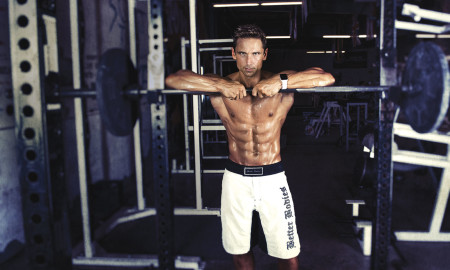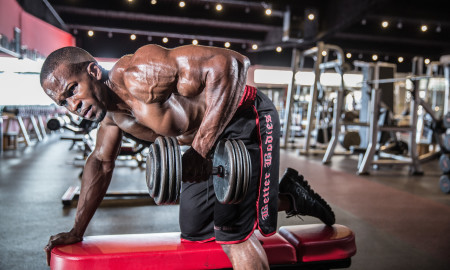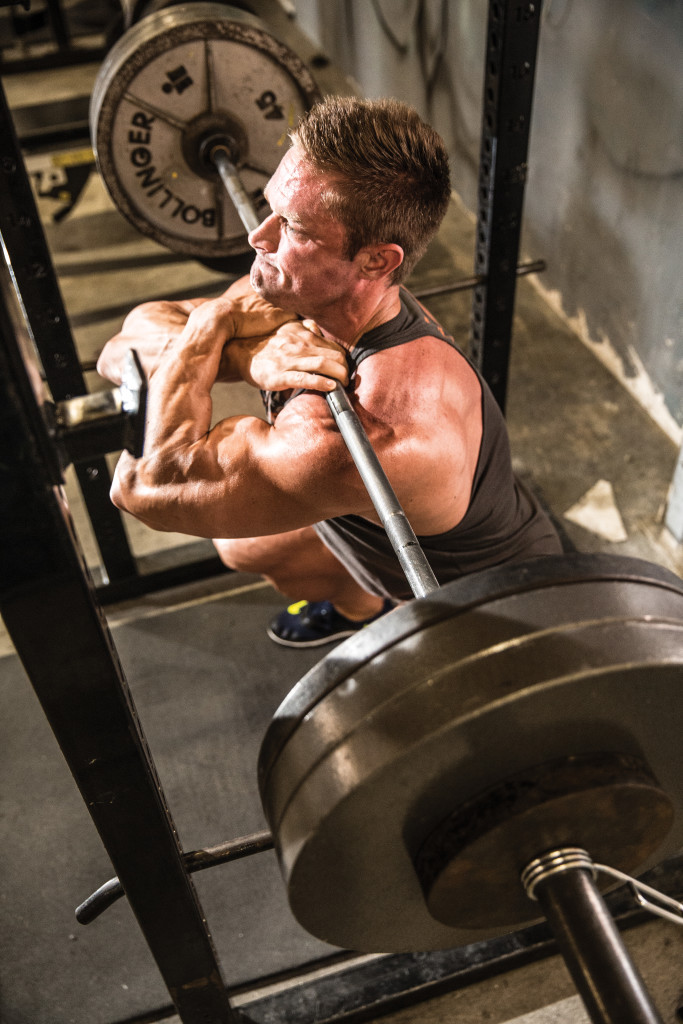

Q: I want to concentrate on my legs this winter and try to put some good-quality size on my quads, which are undersized compared to my upper body. I really need to get going on them and would like to see some changes in my leg size by next summer. I know that barbell squats are the granddaddy of all leg exercises, but because I don’t have a training partner, I’m a bit leery of doing free squats alone. I also have a hard time keeping my upper body straight when I do squats. I always end up working my lower back more than my legs. Would Smith-machine squats be a good substitute? Also, I have long legs, so should I work them twice a week or just once every seven days—and should I increase my calories while I’m trying to make my legs bigger?
A: Building up the legs can be very challenging for those who have long legs. I’m not very tall, but I have a short torso and long legs, so adding mass to my thighs was very hard for me.
You’re right that the barbell squat is the granddaddy of all leg exercises. Performed properly, it’s probably the hardest exercise in existence and the premier exercise for adding mass to the legs. It involves the muscles in your thighs, hips, glutes and lower back, so it’s a very powerful and demanding exercise.
The problem with doing squats for those who are tall or even those who have long legs is that there’s a tendency to bend the upper body forward. That puts more strain on the lower back instead of the legs. If you’ve ever seen pictures of Tom Platz squatting, you know that he kept his upper body completely vertical while using the power of his legs to perform the exercise. Tom also had incredible ankle flexibility, which enabled him to squat with very heavy weights and maintain perfect form. Platz would squat rock bottom on every rep, descending until his hamstrings made contact with his calves.
If you have trouble keeping your upper body straight when doing squats, you can follow a few rules that will really help improve your form. First of all, set your feet slightly wider than shoulder width. Keeping your feet too close together will force your upper body to bend forward. A wider foot stance creates a greater center of gravity, which will help you go deeper and keep your upper body vertical.
Next, point your toes slightly out. If the feet are pointing straight, the knees will go in the same direction. That will place more stress on the quadriceps tendon and will also cause the upper body to tip forward. Pointing the toes outward enables the hips to sink in between the legs at the bottom of the movement while still keeping the upper body tight and upright. Once you are set in the right stance, keep your upper body very tight and flex your lower back so it’s arched and contracted before you begin the exercise.
Slowly descend and make an effort to drop your upper body between your legs so you can go past the parallel point. I see so many people get stuck at the halfway point before tilting the upper body forward. If you focus on sinking straight down, there is no halfway point, and it becomes easier to do a full rep, going all the way down. It’s really a mental strategy, visualizing a full squat with your upper body straight and vertical.
In my opinion, barbell squats are much better for developing the thighs than Smith-machine squats. Some people get good results from doing squats in the Smith machine, but I could never get comfortable with the bar going in a straight line from top to bottom. It didn’t fit my body mechanics, and I always got much better results from using a barbell than the Smith machine.
I suggest you do squats in a power rack with the pins set just below your lowest point at the bottom of the movement. If you’re training by yourself and get stuck at the bottom, you can always dump the bar on the rack without hurting yourself.
You don’t have to go to absolute failure in order to build your legs. The main thing is to do more than you did in your last leg workout. If you can do that consistently, your legs will have to grow to adapt to the increased workload.
A training method that worked for me in developing my legs was to combine heavy, low-rep training with more moderate, high-rep training. I like doing that in the same workout instead of cycling heavy and light workouts. For example, I could do heavy barbell squats at the beginning of the workout for six to eight reps per set and follow that up with leg presses with a more moderate weight, shooting for 12 to 15 reps per set. It’s the combination of heavy training with the basic exercises and higher repetitions with more of an isolation exercise that really helped my quads respond.
As Steve Holman has explained in his articles about X Reps, a stubborn muscle group often responds to more time under tension. If you can find a way to keep the legs under tension for a longer period of time, the muscles will respond by recruiting more muscle fibers, including both the fast-twitch muscle fibers and the slow-twitch fibers.
You can increase the time under tension for a muscle group by using more moderate resistance and doing more repetitions. You can also employ methods such as 1 1/2 reps or emphasizing the negative portion of each rep to make those muscle fibers work harder. That’s a great way to get a stubborn muscle group to respond when traditional training methods—heavy weight and low reps—don’t work.
Here are two workout routines that you can try for your legs using the training methods I described above:
Workout 1
Leg extensions (warmup) 3 x 15-20
Barbell squats 5 x 12, 10, 8, 6, 6
Hack squats (1 1/2 reps) 3 x 10-12
Dumbbell leg curls 4 x 10, 8, 6, 6
Stiff-legged deadlifts (1 1/2 reps) 3 x 10
Workout 2
Leg curls (five-second negatives) 4 x 12, 10, 8, 6
Dumbbell stiff-legged deadlifts 3 x 8-10
Leg extensions (warmup) 3 x 15-20
Leg presses 4 x 10, 8, 6, 6
Front squats (1 1/2 reps) 3 x 8-10
Editor’s note: John Hansen has won the Mr. Natural Olympia and is a two-time Natural Mr. Universe winner. Check out his Web site at www.NaturalOlympia.com, or send questions or comments to [email protected] or at P.O. Box 3003, Darien, IL 60561. Look for John’s DVD, “Natural Bodybuilding Seminar and Competitions,” along with his book, Natural Bodybuilding, and his training DVD, “Real Muscle,” at his Web site or at Home Gym Warehouse, www.Home-Gym.com. Listen to John’s new radio show, “Natural Bodybuilding Radio,” at www.NaturalBodybuildingRadio.com. IM























You must be logged in to post a comment Login